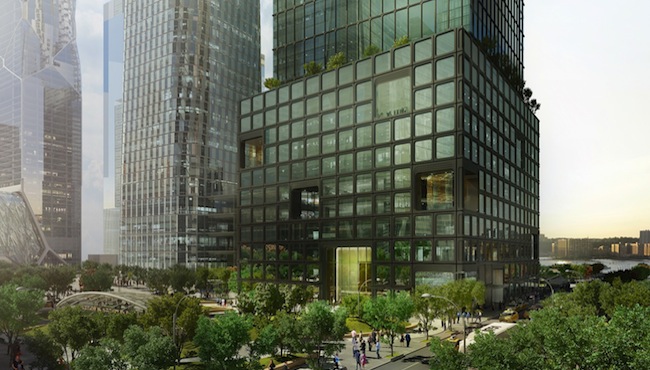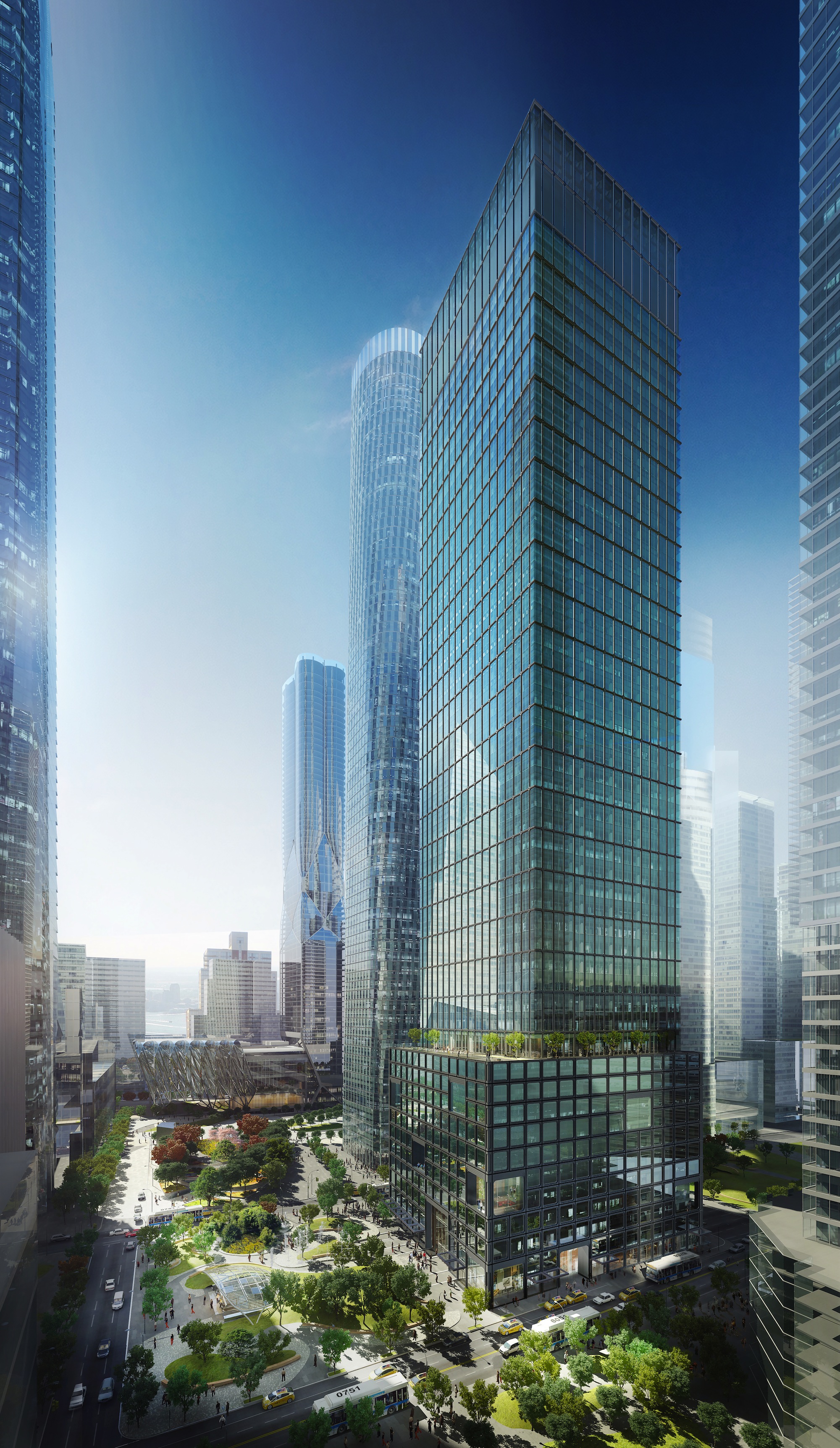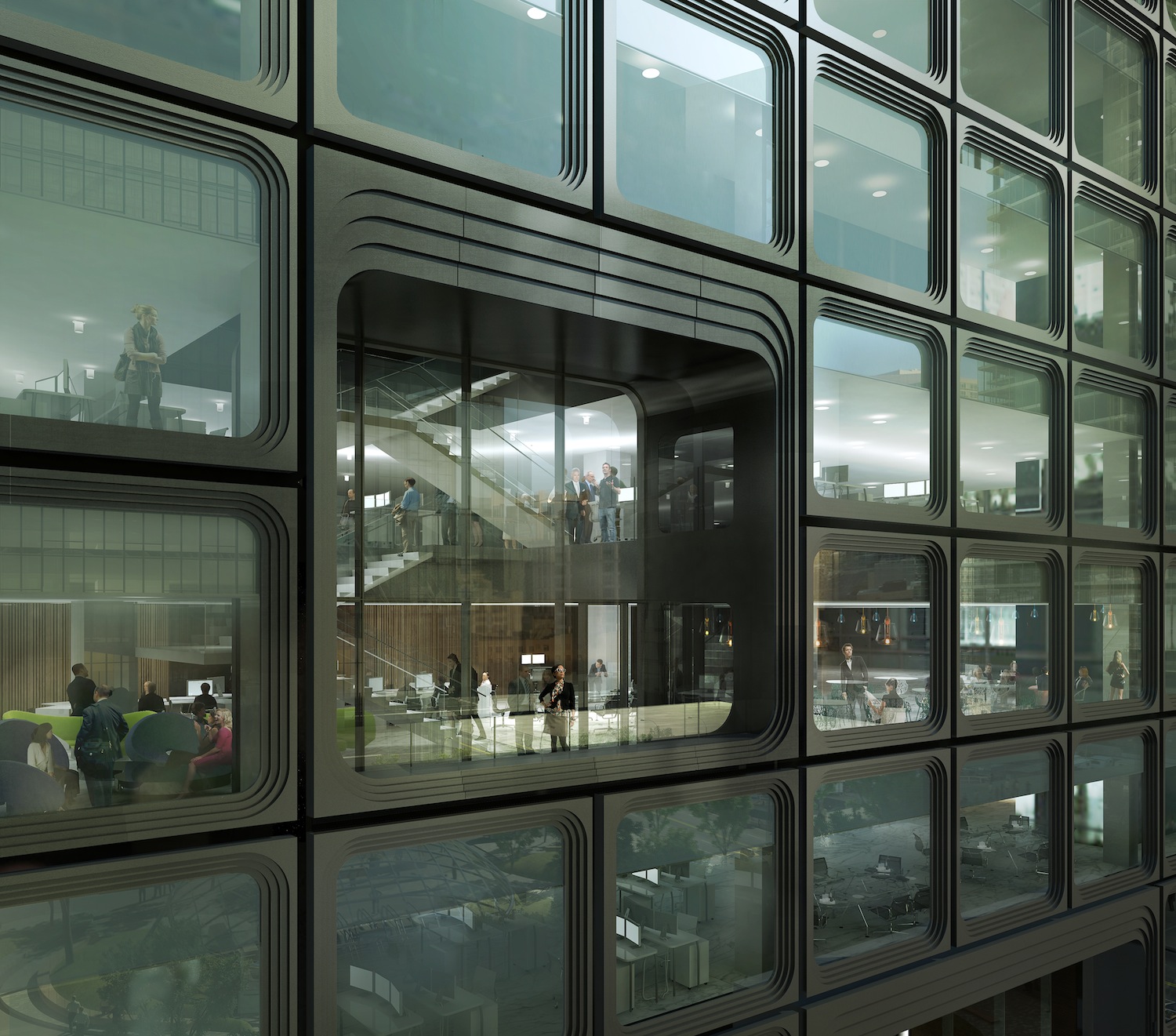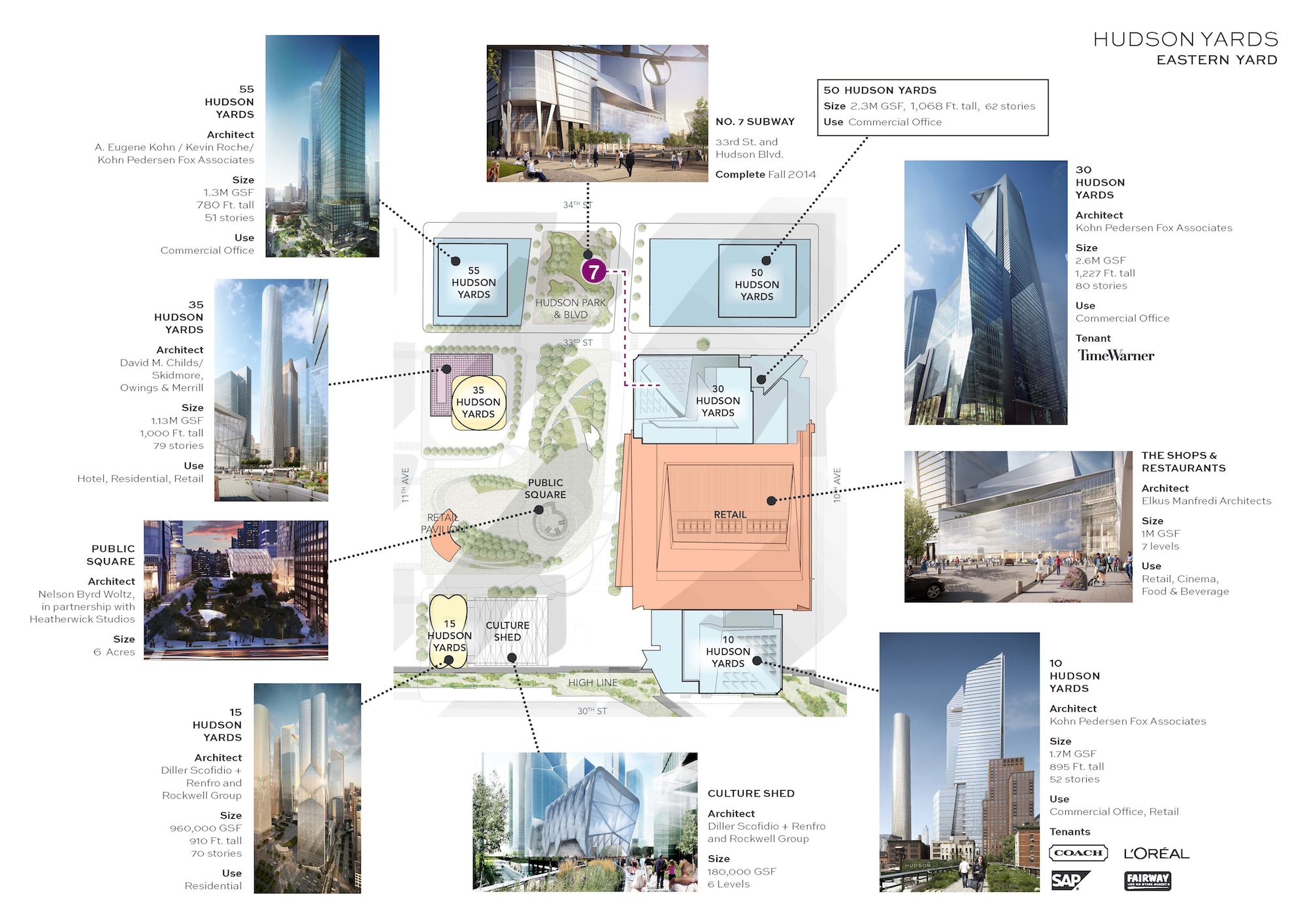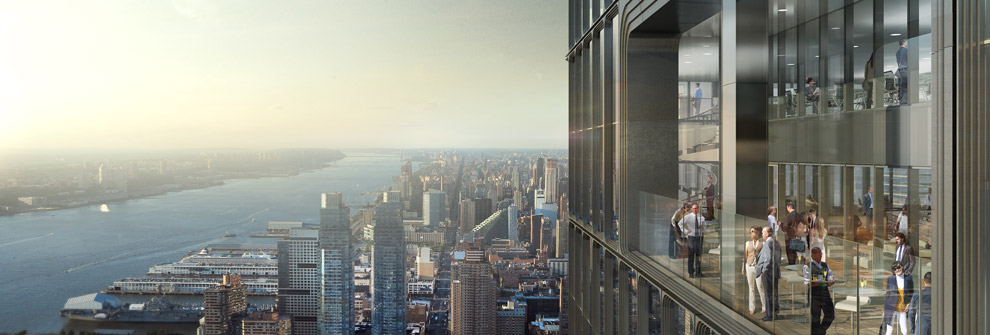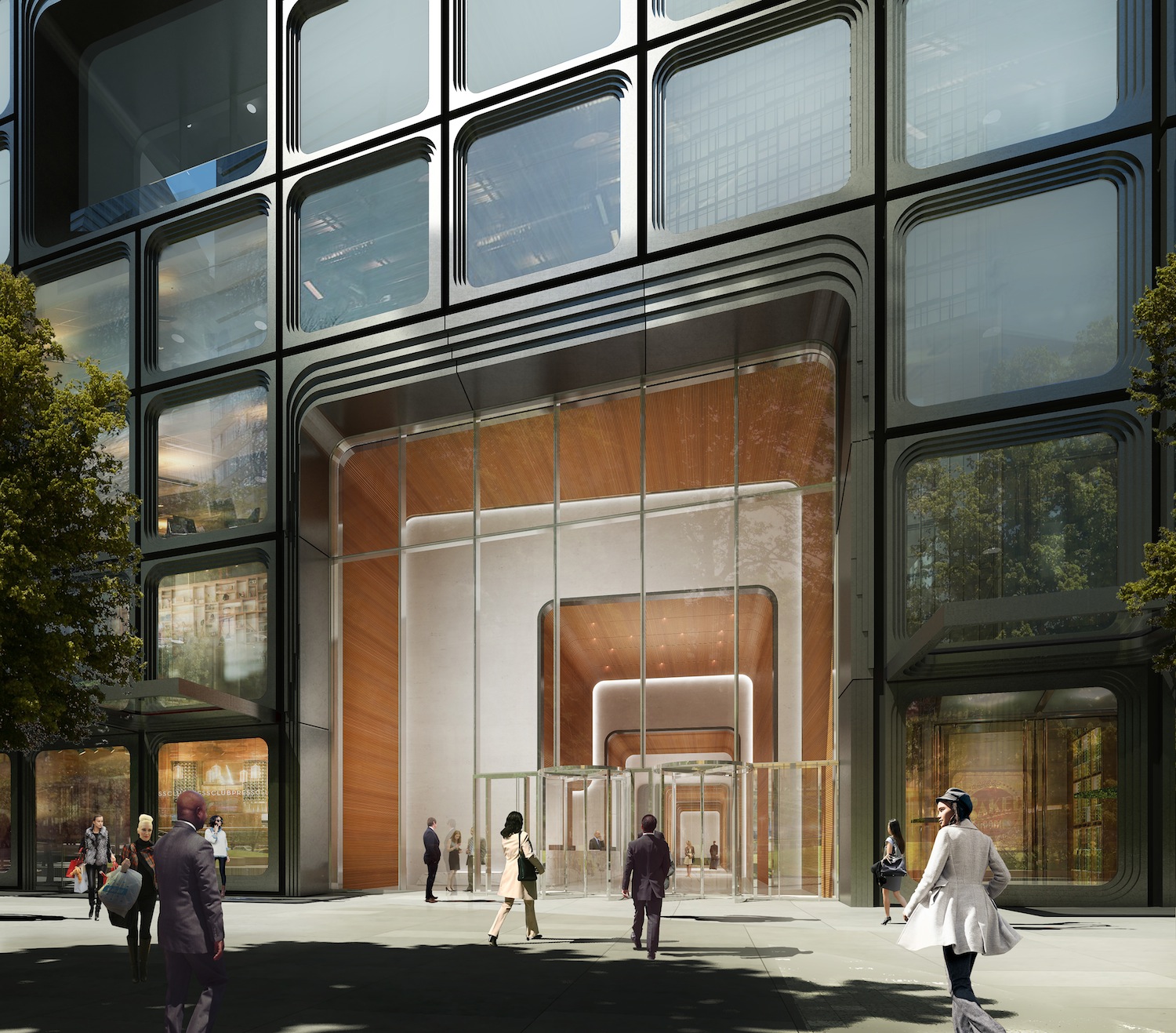Related Companies and Oxford Properties Group today unveiled Fifty Five Hudson Yards, the latest addition to the commercial office tower collection in the 28-acre Hudson Yards development. The building is perfectly positioned at the intersection of Hudson Yards, the High Line and Hudson Park & Boulevard.
The entrance to the building is just across from the new No. 7 subway extension which connects to every other major subway line as well as Grand Central Station. Penn Station is also a less than five-minute walk away. The anticipated LEED Gold, 51-story, 1.3 million gross square foot building is slated to commence construction in January of 2015 and be ready for occupancy at the end of 2017.
The design of Fifty Five Hudson Yards is defined by its indoor-outdoor spaces, SoHo and early modernism inspired exterior design, and exceptionally efficient interior space planning. The conceptual design of the building was a joint venture of A. Eugene Kohn of Kohn Pedersen Fox (KPF) and Pritzker Prize-winning architect Kevin Roche; KPF served as the Design Architect.
One of the few office buildings in the entire city opening directly onto a park, the main lobby of Fifty Five Hudson Yards sits at the southwestern edge of the City’s new Hudson Park. With a unique buffer of green space, light and air around the building, Fifty Five Hudson Yards offers a welcoming arrival experience for building tenants and visitors. The architects built on the appeal of this great outdoor space by designing a dramatic outdoor terrace overlooking the park on the building’s tenth floor.
Situated where the building sets back from the podium floors to the tower, this elegantly landscaped vantage will provide scenic views of Hudson Park as it extends to the north, and the Hudson Yards Public Square and the High Line to the south. The ability to provide gracious indoor-outdoor space continues up the building as the design offers the ability to carve private, double-height terrace spaces into the tower in flexible locations. These tower terraces allow tenants and guests to enjoy an outdoor experience surrounded by superb views of the Hudson River and the Midtown skyline without having to leave the building.
The revitalized High Line district, the manufactured cast iron façade of SoHo commercial buildings and the best of early modernism have inspired the façade of Fifty Five Hudson Yards. The matte metal and stepped articulation of the window frames present a strong and solid exterior appearance, which is modern but uniquely New York in character.
Sun and shadow play across the detailed façade frames creating a visually rich interplay and an unusually strong sense of texture and depth. While the building references the solid exterior of the City’s classic cast iron buildings, it also shares their expansive windows and interior light. Fifty Five Hudson Yards will offer floor-to-ceiling glass throughout the building, bringing light streaming across the entirety of each floor and helping to promote the open skyline and river views it enjoys.
The interior planning of the building was conceived after extensive study of the space needs of professional service, financial, creative and technology firms. The plan starts with a tight, efficient core configuration that eliminates all openings from its perimeter. Without these openings, and with the tower floors free of interior columns, the flexibility of the usable space on each floor is limitless.
Moreover, floor-to-ceiling glass, 35-foot lease-spans and the absence of any corner columns imbue the floors with a sense of light and air through clear-finished, extra-high, 10-foot ceilings. Each floor contains an on-floor, independent HVAC system with single path circulation. The design has multiple opportunities to showcase tenant’s brands and is designed to meet every business need with premium amenities, destination dispatch elevators and designated car drop off access. At a height of over 780 feet, the unobstructed views over the Hudson River and of midtown will be stunning throughout the tower floors.
“Fifty Five Hudson Yards further establishes Hudson Yards as the new heart of New York,” said Jay Cross, President of Related Hudson Yards. “Featuring the best in culture, dining, shopping and more, the commercial office space, steps from transportation and lush, expansive green space, sets a new standard for working in New York City. Today’s business leaders are now more than ever focused on the recruitment and retention of talent and we believe a corporate address at Fifty Five Hudson Yards offers a distinct competitive advantage with a compelling experience inside and outside of the office.”
CLICK MAP TO ENLARGE
South of Fifty Five is the Hudson Yards Public Square, which will serve as an urban stage, celebrating the energy of the City with space for events, exhibitions and gatherings. The Public Square, designed by Thomas Heatherwick and Thomas Woltz, features six acres of gardens and public plazas.
Hudson Yards is the largest private real estate development in the history of the United States and the largest development in New York City since Rockefeller Center. The 28-acre site will include more than 17 million square feet of commercial and residential space, more than 100 shops and restaurants, approximately 5,000 residences, a unique cultural space, 14 acres of public open space, a 750-seat public school and a 150-room luxury hotel—all offering unparalleled amenities for residents, employees and guests. It is anticipated that more than 24 million people will visit Hudson Yards every year.
For more information about Fifty Five Hudson Yards please visit 55HudsonYards.com or www.hudsonyardsnewyork.com.
Related Stories
Adaptive Reuse | Oct 22, 2024
Adaptive reuse project transforms 1840s-era mill building into rental housing
A recently opened multifamily property in Lawrence, Mass., is an adaptive reuse of an 1840s-era mill building. Stone Mill Lofts is one of the first all-electric mixed-income multifamily properties in Massachusetts. The all-electric building meets ambitious modern energy codes and stringent National Park Service historic preservation guidelines.
MFPRO+ News | Oct 22, 2024
Project financing tempers robust demand for multifamily housing
AEC Giants with multifamily practices report that the sector has been struggling over the past year, despite the high demand for housing, especially affordable products.
Performing Arts Centers | Oct 21, 2024
The New Jersey Performing Arts Center breaks ground on $336 million redevelopment of its 12-acre campus
In Newark, N.J., the New Jersey Performing Arts Center (NJPAC) has broken grown on the three-year, $336 million redevelopment of its 12-acre campus. The project will provide downtown Newark 350 mixed-income residential units, along with shops, restaurants, outdoor gathering spaces, and an education and community center with professional rehearsal spaces.
Office Buildings | Oct 21, 2024
3 surprises impacting the return to the office
This blog series exploring Gensler's Workplace Survey shows the top three surprises uncovered in the return to the office.
Healthcare Facilities | Oct 18, 2024
7 design lessons for future-proofing academic medical centers
HOK’s Paul Strohm and Scott Rawlings and Indiana University Health’s Jim Mladucky share strategies for planning and designing academic medical centers that remain impactful for generations to come.
Sports and Recreational Facilities | Oct 17, 2024
In the NIL era, colleges and universities are stepping up their sports facilities game
NIL policies have raised expectations among student-athletes about the quality of sports training and performing facilities, in ways that present new opportunities for AEC firms.
Codes and Standards | Oct 17, 2024
Austin, Texas, adopts AI-driven building permit software
After a successful pilot program, Austin has adopted AI-driven building permit software to speed up the building permitting process.
Resiliency | Oct 17, 2024
U.S. is reducing floodplain development in most areas
The perception that the U.S. has not been able to curb development in flood-prone areas is mostly inaccurate, according to new research from climate adaptation experts. A national survey of floodplain development between 2001 and 2019 found that fewer structures were built in floodplains than might be expected if cities were building at random.
Seismic Design | Oct 17, 2024
Calif. governor signs limited extension to hospital seismic retrofit mandate
Some California hospitals will have three additional years to comply with the state’s seismic retrofit mandate, after Gov. Gavin Newsom signed a bill extending the 2030 deadline.
MFPRO+ News | Oct 16, 2024
One-third of young adults say hurricanes like Helene and Milton will impact where they choose to live
Nearly one-third of U.S. residents between 18 and 34 years old say they are reconsidering where they want to move after seeing the damage wrought by Hurricane Helene, according to a Redfin report. About 15% of those over age 35 echoed their younger cohort’s sentiment.


